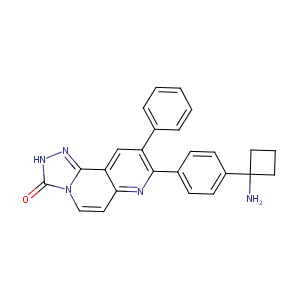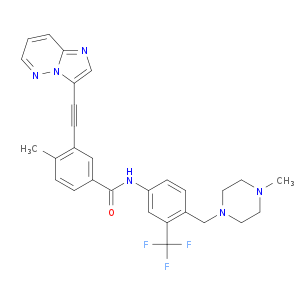| DOT Name |
DOT ID |
UniProt ID |
Mode of Action |
REF |
|
Tyrosine-protein kinase ABL1 (ABL1)
|
OT09YVXH
|
ABL1_HUMAN
|
Decreases Activity
|
[14] |
|
Macrophage colony-stimulating factor 1 receptor (CSF1R)
|
OTDYTB9C
|
CSF1R_HUMAN
|
Decreases Activity
|
[14] |
|
Proto-oncogene tyrosine-protein kinase receptor Ret (RET)
|
OTLU040A
|
RET_HUMAN
|
Decreases Activity
|
[14] |
|
Platelet-derived growth factor receptor beta (PDGFRB)
|
OTYSNK9Q
|
PGFRB_HUMAN
|
Decreases Activity
|
[14] |
|
Fibroblast growth factor receptor 1 (FGFR1)
|
OT4GLCXW
|
FGFR1_HUMAN
|
Decreases Activity
|
[14] |
|
Proto-oncogene tyrosine-protein kinase Src (SRC)
|
OTETYX40
|
SRC_HUMAN
|
Decreases Activity
|
[14] |
|
Serine/threonine-protein kinase B-raf (BRAF)
|
OT7S81XQ
|
BRAF_HUMAN
|
Decreases Activity
|
[14] |
|
Platelet-derived growth factor receptor alpha (PDGFRA)
|
OTDJXUCN
|
PGFRA_HUMAN
|
Decreases Activity
|
[14] |
|
Vascular endothelial growth factor receptor 1 (FLT1)
|
OTT0OGYS
|
VGFR1_HUMAN
|
Decreases Activity
|
[14] |
|
Fibroblast growth factor receptor 2 (FGFR2)
|
OTLOPACK
|
FGFR2_HUMAN
|
Decreases Activity
|
[14] |
|
Fibroblast growth factor receptor 4 (FGFR4)
|
OTRQERG2
|
FGFR4_HUMAN
|
Decreases Activity
|
[14] |
|
Fibroblast growth factor receptor 3 (FGFR3)
|
OTSAXDIL
|
FGFR3_HUMAN
|
Decreases Activity
|
[14] |
|
Ephrin type-A receptor 2 (EPHA2)
|
OTI6QNX2
|
EPHA2_HUMAN
|
Decreases Activity
|
[14] |
|
Ephrin type-A receptor 3 (EPHA3)
|
OTZJF3ML
|
EPHA3_HUMAN
|
Decreases Activity
|
[14] |
|
Vascular endothelial growth factor receptor 3 (FLT4)
|
OTRAA26B
|
VGFR3_HUMAN
|
Decreases Activity
|
[14] |
|
Vascular endothelial growth factor receptor 2 (KDR)
|
OT15797V
|
VGFR2_HUMAN
|
Decreases Activity
|
[14] |
|
Receptor-type tyrosine-protein kinase FLT3 (FLT3)
|
OTMSRYMK
|
FLT3_HUMAN
|
Decreases Activity
|
[14] |
|
Angiopoietin-1 receptor (TEK)
|
OT78YN57
|
TIE2_HUMAN
|
Decreases Activity
|
[14] |
|
Ephrin type-A receptor 7 (EPHA7)
|
OT3VC211
|
EPHA7_HUMAN
|
Decreases Activity
|
[14] |
|
Bcl-2-like protein 11 (BCL2L11)
|
OTNQQWFJ
|
B2L11_HUMAN
|
Increases Expression
|
[15] |
|
Tyrosine-protein kinase JAK2 (JAK2)
|
OTBIDOOR
|
JAK2_HUMAN
|
Decreases Activity
|
[13] |
|
Epidermal growth factor receptor (EGFR)
|
OTAPLO1S
|
EGFR_HUMAN
|
Decreases Activity
|
[13] |
|
Myc proto-oncogene protein (MYC)
|
OTPV5LUK
|
MYC_HUMAN
|
Decreases Expression
|
[15] |
|
Prelamin-A/C (LMNA)
|
OT3SG7ZR
|
LMNA_HUMAN
|
Increases Cleavage
|
[16] |
|
High affinity nerve growth factor receptor (NTRK1)
|
OTJORQAU
|
NTRK1_HUMAN
|
Decreases Activity
|
[13] |
|
Tyrosine-protein kinase Lck (LCK)
|
OT883FG9
|
LCK_HUMAN
|
Decreases Activity
|
[13] |
|
Tyrosine-protein kinase Fyn (FYN)
|
OTLSLVZS
|
FYN_HUMAN
|
Decreases Activity
|
[13] |
|
Tyrosine-protein kinase Lyn (LYN)
|
OTP686K2
|
LYN_HUMAN
|
Decreases Activity
|
[13] |
|
Tyrosine-protein kinase HCK (HCK)
|
OTRL6OSI
|
HCK_HUMAN
|
Decreases Activity
|
[13] |
|
Tyrosine-protein kinase Fgr (FGR)
|
OTCUYU9F
|
FGR_HUMAN
|
Decreases Activity
|
[13] |
|
Poly polymerase 1 (PARP1)
|
OT310QSG
|
PARP1_HUMAN
|
Increases Cleavage
|
[17] |
|
Apoptosis regulator Bcl-2 (BCL2)
|
OT9DVHC0
|
BCL2_HUMAN
|
Decreases Expression
|
[15] |
|
Mast/stem cell growth factor receptor Kit (KIT)
|
OTHUY3VZ
|
KIT_HUMAN
|
Decreases Activity
|
[13] |
|
Breakpoint cluster region protein (BCR)
|
OTCN76C1
|
BCR_HUMAN
|
Decreases Phosphorylation
|
[13] |
|
Cyclin-dependent kinase 4 (CDK4)
|
OT7EP05T
|
CDK4_HUMAN
|
Decreases Expression
|
[15] |
|
Troponin I, cardiac muscle (TNNI3)
|
OT65E12V
|
TNNI3_HUMAN
|
Increases Secretion
|
[18] |
|
Ephrin type-A receptor 1 (EPHA1)
|
OTGJMRZ0
|
EPHA1_HUMAN
|
Decreases Activity
|
[13] |
|
Tyrosine-protein kinase JAK1 (JAK1)
|
OT0X3D17
|
JAK1_HUMAN
|
Decreases Activity
|
[13] |
|
Alanine aminotransferase 1 (GPT)
|
OTOXOA0Q
|
ALAT1_HUMAN
|
Increases Secretion
|
[19] |
|
Mitogen-activated protein kinase 3 (MAPK3)
|
OTCYKGKO
|
MK03_HUMAN
|
Decreases Phosphorylation
|
[20] |
|
Mitogen-activated protein kinase 1 (MAPK1)
|
OTH85PI5
|
MK01_HUMAN
|
Decreases Phosphorylation
|
[20] |
|
Ephrin type-A receptor 8 (EPHA8)
|
OTHOESG6
|
EPHA8_HUMAN
|
Decreases Activity
|
[13] |
|
Ephrin type-B receptor 2 (EPHB2)
|
OT8VZ6C5
|
EPHB2_HUMAN
|
Decreases Activity
|
[13] |
|
RAC-alpha serine/threonine-protein kinase (AKT1)
|
OT8H2YY7
|
AKT1_HUMAN
|
Decreases Phosphorylation
|
[15] |
|
Cyclin-dependent kinase inhibitor 1 (CDKN1A)
|
OTQWHCZE
|
CDN1A_HUMAN
|
Increases Expression
|
[15] |
|
Tyrosine-protein kinase CSK (CSK)
|
OTP03OD0
|
CSK_HUMAN
|
Decreases Activity
|
[13] |
|
Signal transducer and activator of transcription 5A (STAT5A)
|
OTBSJGN3
|
STA5A_HUMAN
|
Decreases Phosphorylation
|
[16] |
|
Caspase-3 (CASP3)
|
OTIJRBE7
|
CASP3_HUMAN
|
Increases Cleavage
|
[21] |
|
Tyrosine-protein kinase ABL2 (ABL2)
|
OTS8F4GD
|
ABL2_HUMAN
|
Decreases Activity
|
[13] |
|
Tyrosine-protein kinase FRK (FRK)
|
OTEKV1SC
|
FRK_HUMAN
|
Decreases Activity
|
[13] |
|
Crk-like protein (CRKL)
|
OTOYSD1R
|
CRKL_HUMAN
|
Decreases Phosphorylation
|
[18] |
|
Tyrosine-protein kinase Blk (BLK)
|
OT1EB8MT
|
BLK_HUMAN
|
Decreases Activity
|
[13] |
|
Cytoplasmic tyrosine-protein kinase BMX (BMX)
|
OTJUE0ZD
|
BMX_HUMAN
|
Decreases Activity
|
[13] |
|
Tyrosine-protein kinase JAK3 (JAK3)
|
OTQ8QW2L
|
JAK3_HUMAN
|
Decreases Activity
|
[13] |
|
Ephrin type-B receptor 3 (EPHB3)
|
OT4XD8O3
|
EPHB3_HUMAN
|
Decreases Activity
|
[13] |
|
Ephrin type-A receptor 5 (EPHA5)
|
OTAM0CVX
|
EPHA5_HUMAN
|
Decreases Activity
|
[13] |
|
Ephrin type-B receptor 4 (EPHB4)
|
OTKLPVXJ
|
EPHB4_HUMAN
|
Decreases Activity
|
[13] |
|
Ephrin type-B receptor 1 (EPHB1)
|
OTPG2DRZ
|
EPHB1_HUMAN
|
Decreases Activity
|
[13] |
|
Ephrin type-A receptor 4 (EPHA4)
|
OT3AMK0C
|
EPHA4_HUMAN
|
Decreases Activity
|
[13] |
|
Cyclin-dependent kinase 6 (CDK6)
|
OTR95N0X
|
CDK6_HUMAN
|
Decreases Expression
|
[15] |
|
Induced myeloid leukemia cell differentiation protein Mcl-1 (MCL1)
|
OT2YYI1A
|
MCL1_HUMAN
|
Decreases Expression
|
[20] |
|
Protein-tyrosine kinase 6 (PTK6)
|
OT7NWIQ0
|
PTK6_HUMAN
|
Decreases Activity
|
[13] |
|
Protein-tyrosine kinase 2-beta (PTK2B)
|
OTGAS0I8
|
FAK2_HUMAN
|
Decreases Activity
|
[13] |
|
Receptor tyrosine-protein kinase erbB-4 (ERBB4)
|
OT9L6C41
|
ERBB4_HUMAN
|
Decreases Activity
|
[13] |
|
NT-3 growth factor receptor (NTRK3)
|
OTII30MY
|
NTRK3_HUMAN
|
Decreases Activity
|
[13] |
|
BDNF/NT-3 growth factors receptor (NTRK2)
|
OTD557PU
|
NTRK2_HUMAN
|
Decreases Activity
|
[13] |
|
Discoidin domain-containing receptor 2 (DDR2)
|
OT9IHOGZ
|
DDR2_HUMAN
|
Decreases Activity
|
[13] |
|
Microtubule-associated proteins 1A/1B light chain 3A (MAP1LC3A)
|
OTPMGIU4
|
MLP3A_HUMAN
|
Increases Lipidation
|
[21] |
| ------------------------------------------------------------------------------------ |
|
|
|
|


